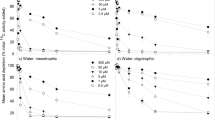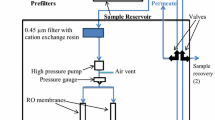Abstract
Different nominal molecular weight (nMW) fractions of DOC from a southeastern blackwater river were concentrated by ultrafiltration and added to sieved river water to assess each fraction's ability to stimulate bacterial growth. Bacterial growth was measured using change in bacterial biomass from direct counts and using3H-thymidine incorporated into DNA. Bacterial growth and amount of DOC used was greatest in the low MW enrichment (< 1,000 nMW) and least in the intermediate MW enrichment (1,000–10,000 nMW). The high MW fraction (> 10,000 nMW) supported more growth than did the intermediate MW fraction, apparently because of lower MW compounds complexed with a high MW refractory core. The low MW fraction of DOC from a clearwater mountain stream, a boreal blackwater river, and leachate from water oak and willow leaves also stimulated more bacterial growth than did other fractions. However, the high MW DOC from these other sources was not as biologically available as high MW DOC from a blackwater river. Bacteria converted blackwater river DOC to bacterial biomass with an efficiency of 31%. Bacteria produced at the expense of abundant riverine DOC provide a trophic resource for protozoa and higher levels of the microbial food web of a blackwater river.
Similar content being viewed by others
References
Aiken GR (1984) Evaluation of ultrafiltration for determining molecular weight of fulvic acid. Environ Sci Technol 18:978–981
Allen HL (1976) Dissolved organic matter in lakewater: Characteristics of molecular weight size-fractions and ecological implications. Oikos 27:64–70
Azam F, Holm-Hansen O (1973) Use of tritiated substrates in the study of heterotrophy in seawater. Mar Biol 23:191–196
Azam F, Fenchel T, Field JG, Gray JS, Meyer-Reil LA, Thingstad F (1983) The ecological role of water column microbes in the sea. Mar Ecol Prog Ser 10:257–263
Bauerfeind S (1985) Degradation of phytoplankton detritus by bacteria: Estimation of bacterial consumption and respiration in an oxygen chamber. Mar Ecol Prog Ser 21:27–36
Beck KC, Reuter JH, Perdue EM (1974) Organic and inorganic geochemistry of some coastal plain rivers of the southeastern United States. Geochim Cosmochim Acta 38:341–364
Benke AC, Henry RL, Gillespie DM, Hunter RJ (1985) Importance of snag habitat for animal production in southeastern streams. Fisheries 10(5):8–13
Benke AC, Van Arsdall TC, Gillespie DM, Parrish FK (1984) Invertebrate productivity in a subtropical blackwater river: The importance of habitat and life history. Ecol Monogr 54:25–63
Bott TL, Kaplan LA, Kuserk FT (1984) Benthic bacterial biomass supported by streamwater dissolved organic matter. Microb Ecol 10:335–344
Bratbak G (1985) Bacterial biovolume and biomass estimations. Appl Env Microbiol 49:1488–1493
Dahm CN (1981) Pathways and mechanisms for removal of dissolved organic carbon from leaf leachate in streams. Can J Fish Aquat Sci 38:68–76
de Haan H (1974) Effect of a fulvic acid fraction on the growth of a Pseudomonas from Tjeukemeer (The Netherlands). Freshwat Biol 4:301–310
de Haan H (1977) Effect of benzoate on microbial decomposition of fulvic acids in Tjeukemeer (The Netherlands). Limnol Oceanogr 22:38–44
D'Elia C, Steudler PA, Corwin N (1977) Determination of total nitrogen in aqueous samples using persulfate digestion. Limnol Oceanogr 22:760–764
Edwards RT (in press) Seasonal bacterial biomass dynamics in the seston of two southeastern blackwater rivers. Limnol Oceanogr
Findlay SG, Meyer JL, Edwards RT (1984) Measuring bacterial production via rate of incorporation of3H-thymidine into DNA. Jour Microbiol Meth 2:57–72
Findlay SG, Carlough L, Crocker MT, Gill HK, Meyer JL, Smith PJ (in press) Bacterial growth on macrophyte leachate and fate of bacterial production. Limnol Oceanogr
Findlay SG, Meyer JL, Risley R (1986) Benthic bacterial biomass and production in two blackwater rivers. Can Jour Fish Aquat Sci 43:1271–1276
Ford TE, Lock MA (1985) A temporal study of colloidal and dissolved organic carbon in rivers: Apparent molecular weight spectra and their relationship to bacterial activity. Oikos 45:71–78
Geller A, Stabel HH (1985) Dissolved organic macromolecular and oligomeric lake water constituents: Preliminary characterization and biodegradability. Org Geochem 8:143
Hessen DO (1985) The relation between bacterial carbon and dissolved humic compounds in oligotrophic lakes. FEMS Microbiol Ecol 31:215–223
Hobbie J, Daley R, Jaspar S (1977) Use of nuclepore filters for counting bacteria by fluorescent microscopy. Appl Environ Microbiol 33:1225–1228
Kaplan LA, Bott TL (1983) Microbial heterotrophic utilization of dissolved organic matter in a piedmont stream. Freshwat Biol 13:363–377
Larson RA (1978) Dissolved organic matter of a low-coloured stream. Freshwat Biol 8:91–104
Lock JA, Ford TE (1985) Microcalorimetric approach to determine relationships between energy supply and metabolism in river epilithon. Appl Env Microbiol 49:408–412
Lytle CR, Perdue EM (1981) Free, proteinaceous, and humic-bound amino acids in river water containing high concentrations of aquatic humus. Environ Sci Technol 15:224–228
Meyer JL, Tate CM (1983) The effect of watershed disturbance on dissolved organic carbon dynamics of a stream. Ecol 64:33–44
Meyer JL (1986) Dissolved organic carbon dynamics in two subtropical blackwater rivers. Arch Hydrobiol 108
Moore RM, Burton JD, Williams PJ, Young ML (1979) The behavior of dissolved organic material, iron and manganese in estuarine mixing. Geochim Cosmochim Acta 43:919–926
Moriarty DJW, Pollard P (1981) DNA synthesis as a measure of bacterial productivity in seagrass sediments. Mar Ecol Prog Ser 5:151–156
Moriarty DJW (1984) Measurements of bacterial growth rates in aquatic systems using rates of nucleic acid synthesis. Adv Aquatic Microbiol 84:1–20
Naiman RJ (1982) Characteristics of sediment and organic carbon export from pristine boreal forest watersheds. Can J Fish Aquat Sci 39:1699–1718
Ogura N (1975) Further studies on decomposition of dissolved organic matter in coastal seawater. Mar Biol 31:101–111
Prakash A, Rashid MA, Jensen A, Subba Rao DV (1973) Influence of humic substances on the growth of marine phytoplankton: Diatoms. Limnol Oceanogr 18:516–524
Roberston ML, Mills AL, Zieman JC (1982) Microbial synthesis of detritus-like particulates from dissolved organic carbon released by tropical seagrasses. Mar Ecol Prog Ser 7:279–285
Salonen K, Kononen K, Arvola L (1983) Respiration of plankton in two small polyhumic lakes. Hydrobiologia 101:65–70
Sederholm H, Mauranen A, Montonen L (1973) Some observations on the microbial degradation of humous substances in water. Verh Internat Verein Limnol 18:1301–1305
Smock LA, Gilinsky E, Stoneburner DL (1985) Macroinvertebrate production in a southeastern United States blackwater stream. Ecol 66:1491–1503
St.John TV, Anderson AB (1982) A re-examination of plant phenolics as a source of tropical black water rivers. Trop Ecol 23:151–154
Stewart AJ, Wetzel RG (1982) Influence of humic materials on carbon assimilation and alkaline phosphatase activity in natural algal-bacterial assemblages. Freshwat Biol 12:369–380
Strome DJ, Miller MC (1978) Photolytic changes in dissolved humic substances. Verh Internat Verein Limnol 20:1248–1254
Sweet MS, Perdue EM (1982) Concentration and speciation of dissolved sugars in river water. Environ Sci Technol 16:692–698
Thurman EM, Wershaw RL, Malcolm RL, Pinckney DJ (1982) Molecular size of aquatic humic substances. Org Geochem 4:27–35
Thurman EM (1985) Organic geochemistry of natural waters. Nijhoff/Junk Publ, Dordrecht
Visser SA (1985) Effect of humic acids on numbers and activities of micro-organisms within physiological groups. Org Geochem 8:81–85
Wallace JB, Benke AC (1984) Quantification of wood habitat in subtropical coastal plain streams. Can J Fish Aquat Sci 41:1643–1652
Wetzel RG (1983) Limnology, 2nd Ed. Saunders Publ, New York
Wetzel RG, Manny BA (1972) Decomposition of dissolved organic carbon and nitrogen compounds from leaves in an experimental hardwater stream. Limnol Oceanogr 17:927–931
Williams PJ (1984) Bacterial production in the marine food chain: The emperor's new suit of clothes? In: Fasham M (ed) Flows of energy and materials in marine ecosystems. NATO Conference Series IV, vol. 13, Plenum Press, New York, pp 271–299
Wotton RS (1976) Evidence that blackfly larvae can feed on particles of colloidal size. Nature 261:697
Author information
Authors and Affiliations
Rights and permissions
About this article
Cite this article
Meyer, J.L., Edwards, R.T. & Risley, R. Bacterial growth on dissolved organic carbon from a blackwater river. Microb Ecol 13, 13–29 (1987). https://doi.org/10.1007/BF02014960
Issue Date:
DOI: https://doi.org/10.1007/BF02014960




